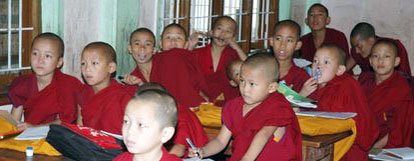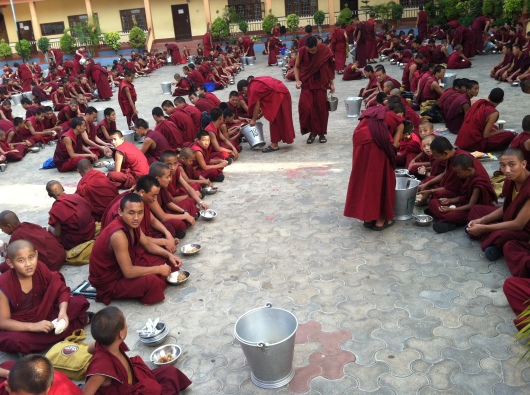Lesson One: Common Culture
Before departing for India, I was warned, “I think you’re going to be in for a bit of culture shock.” In truth, my biggest shock during my trip was how utterly un-shocking everything was. At least for me, the small but crowded city of Kushalnagar, a brief tuk-tuk away from Sera, was incomparably more navigable than the New York City an hour away from my home. The streets were much the same, save for the differently colored dirt along the sides and the completely lawless yet cooperative and fairly effective Indian driving style.
Most importantly, though, all of the people with whom I interacted were easy-going and friendly. This was the case both at the monastery and elsewhere. Instead of focusing on where to walk, who to avoid, and who’s safe to talk to, I spent my time eagerly in conversations and making friends. Reflecting on my conversations throughout the trip, a primary takeaway is that despite our cultural differences, I related quickly and easily with everyone I met. Of course, I was in a somewhat sheltered environment at the monastery and not in a major city when I left it, but I believe this lesson still holds value.
My Indian experience highlighted the common culture we all seem to share no matter the country or region, and which should be celebrated just as much as our differences, as a uniting element among peoples who ultimately face the many of the same basic human desires and problems.
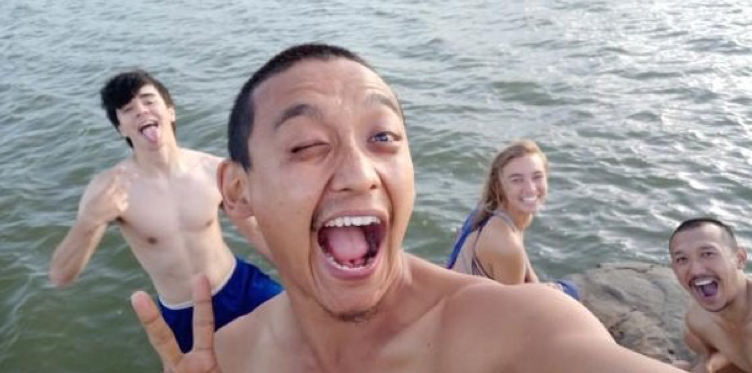 Me and Molly with Tsering (middle) and Jamyang, two monks from Sera. Tsering, who we called “Lungto,” became a good friend to us and took us to a stunning lake with Jamyang on our last day. We miss you Lungto!
Me and Molly with Tsering (middle) and Jamyang, two monks from Sera. Tsering, who we called “Lungto,” became a good friend to us and took us to a stunning lake with Jamyang on our last day. We miss you Lungto!
Lesson Two: A New Area of Interest, A New Eagerness to Learn
 From left to right: Me, Dr. Pierce, Tony, Chris (Dr. Pierce’s co-instructor), and Molly. Tony served as a translator for Dr. Pierce’s class, will be conducting neuroscience research in Russia in the Fall, and is a genuine guy with a great catch phrase: “Time to lunch!”
From left to right: Me, Dr. Pierce, Tony, Chris (Dr. Pierce’s co-instructor), and Molly. Tony served as a translator for Dr. Pierce’s class, will be conducting neuroscience research in Russia in the Fall, and is a genuine guy with a great catch phrase: “Time to lunch!”
My second lesson in India was to remain open to new chances to learn. At the monastery, where the monks debate daily, discourse is encouraged and the monks are eager to talk to us about anything at all. Taking advantage of this opportunity, I had many fantastic conversations at the monastery about culture, the monks’ lifestyles, and Buddhist philosophy. I even had the privilege of meeting the abbot of the monastery, who recently won the British Empire Medal for his work in Buddhism education in the United Kingdom. With him, I discussed different aspects of studying Buddhism from a Western educational and cultural background, and he had fantastic advice for me as someone interested in learning more.
Through all of my conversations during the trip, my interest in studying Buddhism blossomed into a passion and an eagerness to learn. This is one of the things I am most grateful for from the experience; it is a lasting passion that may possibly lead my professional life in a new direction, but will certainly teach me to act and think in new and helpful ways which apply to all areas of my life.
Lesson Three: Don’t Be Ashamed of Where You’re From
As an American coming from another culture with somewhat differing values and a different educational background, how can I expect to succeed in a place like India or a Tibetan community within it? This fear was slowly, but not entirely, assuaged during my stay at Sera. Speaking with the monks, a common theme was that many were eager to speak with us because of our unique background. A few monks even asked me about my academic background in philosophy, genuinely interested in the differences in topics, methods of analysis, and cultural influences between Buddhist and Western philosophy.
Through this experience, I realized that I had been viewing my background as a disadvantage in my new environment, and that this attitude had been unproductive and even held me back in some invaluable learning opportunities – my shyness and fear of offending anyone had kept me quiet in times when I now see there was no danger at all. Rather, I learned to see my academic background as an advantage in many ways, and for the second part of the trip focused on cultivating my differences in a positive, productive way.
 A panoramic view of Sera and its surroundings from the balcony where Molly and I meditated in the mornings. A sight I hope I’ll never forget!
A panoramic view of Sera and its surroundings from the balcony where Molly and I meditated in the mornings. A sight I hope I’ll never forget!
Lesson Four: Balance of Ambitions
It seems plausible that happiness or success, however one defines them, might be found in many places and in many forms. One lesson from seeing India in person is that a lack of my home culture and amenities may turn out to be miniscule in comparison to the benefits of a change in location and lifestyle. As I learned from Nicolas, the Canadian monk whose interview will also be posted on this blog when technology cooperates, even a Westerner might find contentedness and peace in a place as remote as Sera. As he emphasized to me, he is a monk at Sera simply because he loves to be there.
Realistically, many people cannot hope to change location in quite this manner – people have ties and relationships in the places they come from. However, Nicolas still showed me that there is a world of possibility for learning through travel, and that maybe I can do it while maintaining a job and life in America, too. As a young American, I see clearly that many people my age naturally agonize over where they will be and what they will be doing in their future. They may wish to stay in the US forever, to travel abroad often, or to live abroad forever. In my view, herein lies the immense value of the EnCompass programs and other like them – they are able to provide some much-needed perspective for young people rapidly who face many paths forward in a confusing and overwhelming world. Whether I become a financial analyst, professor of philosophy, a monk, some combination of these, or something entirely different, I am able to make a more informed, comfortable, and confident decision because of my experience.

This photo (taken at a hotel our first morning in India) is poorly lit, but I think it really captures the big smile I had throughout the trip! 🙂
Final Lesson: Some Food is Definitely Too Spicy for Me, and I’m Okay with Admitting That Now
I’m just going to say I learned that no matter how delicious the food was at one of my first meals in India, sweating and red lips should have been a good enough indicator that I might be making the following few days less pleasant than they could have been. I will not provide any more details on how I learned this lesson…
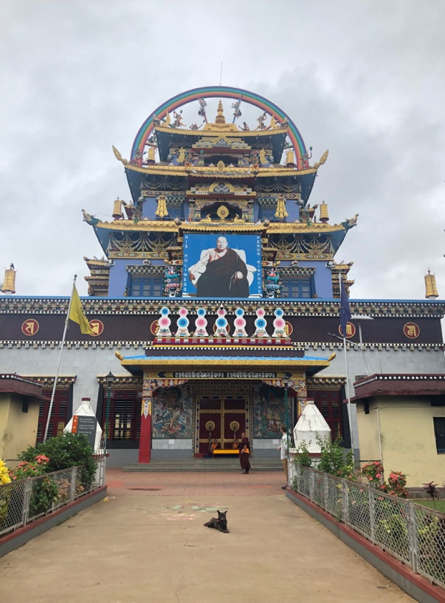
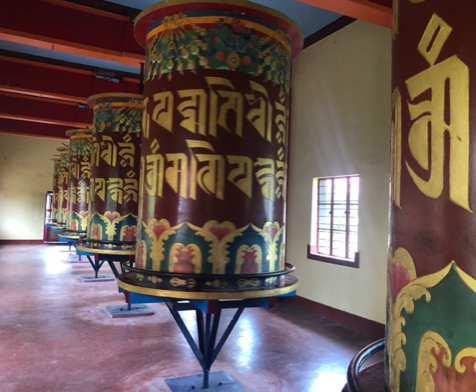
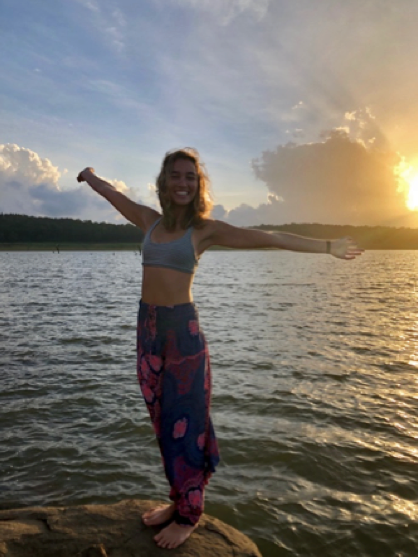

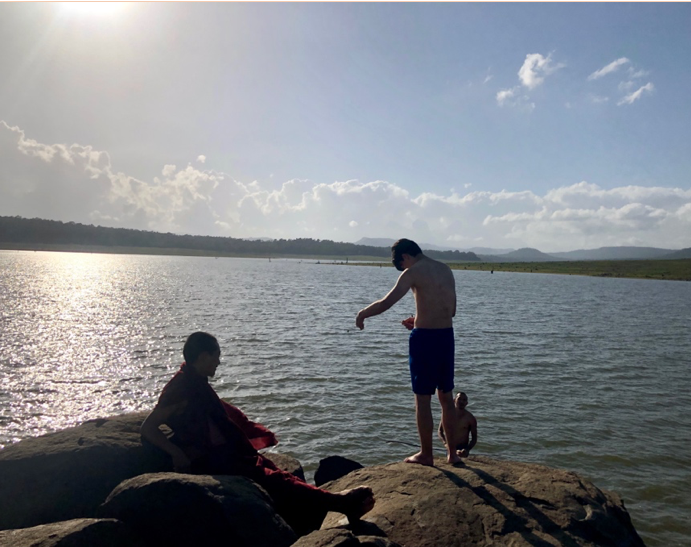
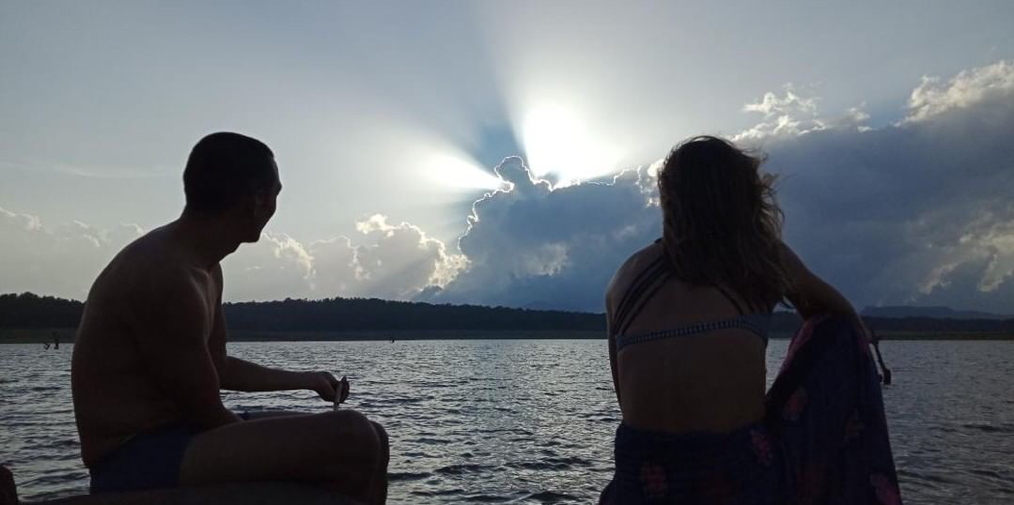 Afterwards, they treated us to dinner and we promised them we would take them out for a bite when they come to visit us in America. Thanks to this experience, I really want a motorcycle to feel that feeling of freedom and true happiness back home, and because I also told our friend I would take him for a ride on my motorcycle when he comes to visit.
Afterwards, they treated us to dinner and we promised them we would take them out for a bite when they come to visit us in America. Thanks to this experience, I really want a motorcycle to feel that feeling of freedom and true happiness back home, and because I also told our friend I would take him for a ride on my motorcycle when he comes to visit.
 From left to right: Me, Dr. Pierce, Tony, Chris (Dr. Pierce’s co-instructor), and Molly. Tony served as a translator for Dr. Pierce’s class, will be conducting neuroscience research in Russia in the Fall, and is a genuine guy with a great catch phrase: “Time to lunch!”
From left to right: Me, Dr. Pierce, Tony, Chris (Dr. Pierce’s co-instructor), and Molly. Tony served as a translator for Dr. Pierce’s class, will be conducting neuroscience research in Russia in the Fall, and is a genuine guy with a great catch phrase: “Time to lunch!” A panoramic view of Sera and its surroundings from the balcony where Molly and I meditated in the mornings. A sight I hope I’ll never forget!
A panoramic view of Sera and its surroundings from the balcony where Molly and I meditated in the mornings. A sight I hope I’ll never forget!
















